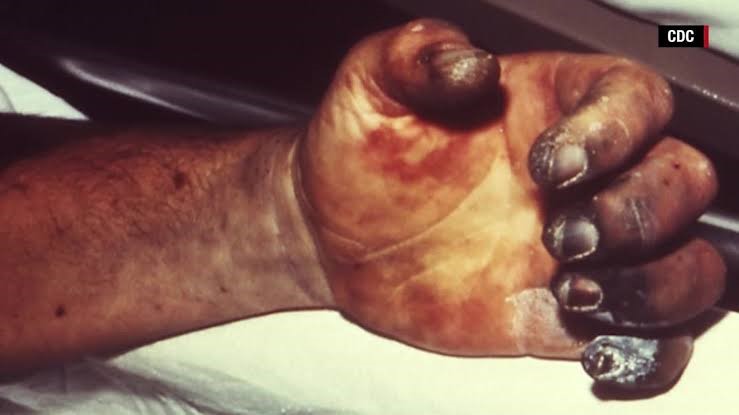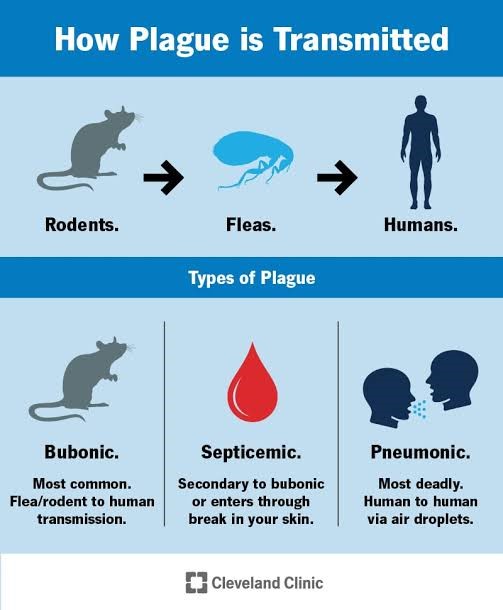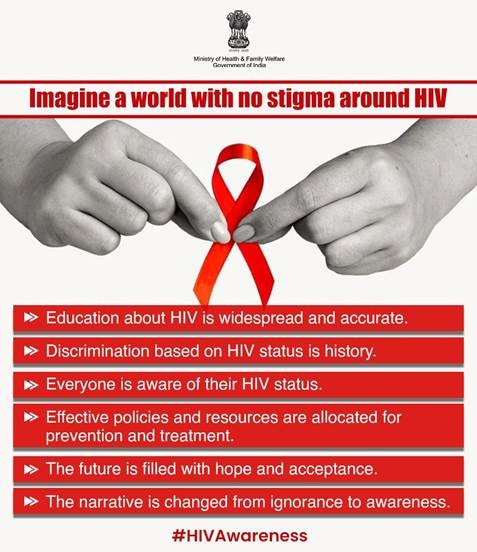
Copyright infringement not intended.
Context: China's northern region of Inner Mongolia reported two cases of bubonic plague.
What is the bubonic plague?
- Plague is an infectious disease caused by a specific type of bacteria called Yersinia pestis.
- pestis can affect humans and animals and is spread mainly by fleas.
- Bubonic plague is one type of plague.
- It gets its name from the swollen lymph nodes (buboes) caused by the disease.
- The nodes in the armpit, groin and neck can become as large as eggs and can ooze pus.
The other types of plague are:
- Septicemic plague, which happens when the infection goes all through the body.
- Pneumonic plague, which happens when the lungs are infected.
The symptoms of bubonic plague
Bubonic plague symptoms include:
- Sudden high fever and chills.
- Pains in the areas of the abdomen, arms and legs.
-
- Large and swollen lumps in the lymph nodes (buboes) that develop and leak pus.
Cause and transmission of the disease
- Bubonic plague is caused by the Yersinia pestis(Y. pestis) bacterium which is spread mostly by fleas on rodents and other animals.
- Humans who are bitten by fleas then can come down with the plague.
- It’s an example of a disease that can spread between animals and people (a zoonotic disease).
- Cats in particular are vulnerable to plague and can be infected by eating sick rodents. These cats can pass droplets infected with plague to their owners or to the veterinarians that treat them.
- Person-to-person spread is unlikely, except in rare cases of someone who has pneumonic plague (infected lungs) spreading plague through droplets sprayed into the air.

Treatment
The bubonic plague can be treated and cured with antibiotics. In some cases, you may be put into an isolation unit.
Antibiotics that treat bubonic plague include:
- Ciprofloxacin, levofloxacin and moxifloxacin.
- Gentamicin
- Doxycycline
What happens if the bubonic plague isn’t treated?
- Bubonic plague can be fatal if it’s not treated.
- It can create infection throughout the body (septicemic plague) and/or infect your lungs (pneumonic plague.)
- Without treatment, septicemic plague and pneumonic plague are both fatal.
The bubonic plague of medieval times
- Bubonic plague deaths exceeded 25 million people during the fourteenth century. This was about two-thirds of the population in Europe at the time.
- Rats travelled on ships and brought fleas and plague with them.
- Because most people who got the plague died, and many often had blackened tissue due to gangrene, the bubonic plague was called the Black Death. A cure for bubonic plague wasn’t available.
Does the bubonic plague still exist?
- There have been other episodes of bubonic plague in world history apart from the Black Death years (1346-1353).
- Bubonic plague still occurs throughout the world and in the U.S., with cases in Africa, Asia, South America and the western areas of North America.

Deadliest plagues in History
- The first began with the Plague of Justinian, which ravaged the Byzantine Empire and surrounding areas in 541 and 542; the pandemic persisted in successive waves until the middle of the 8th century.
- The second began with the Black Death, which killed at least one-third of Europe's population in a series of expanding waves of infection from 1346 to 1353; this pandemic recurred regularly until the 19th century.
- The third plague pandemic was a major bubonic plague pandemic that began in Yunnan, China, in 1855. This episode of bubonic plague spread to all inhabited continents and ultimately led to more than 12 million deaths in India and China
India and bubonic plague
- On 23 September 1896, the first “official" case of the bubonic plague in India was reported by an Indian physician named A.G. Viegas from a house near Masjid Bridge in Mandvi district, Bombay Presidency.
How did it come to India?
- Originating in Yunnan, China, the plague travelled across the country to Hong Kong, from where it arrived in British India and the rest of the world, through trading ships.
- From thereon, the mahamari (epidemic) spread rapidly to the port cities of Calcutta and Karachi, and further to Pune, the United Provinces, Punjab, North West Frontier Province, Hyderabad, Mysore, Madras, Agra, Oudh and Burma.
- “Between (the) plague’s arrival in 1896 and 1921, an estimated 12 million Indians lost their lives, compared with 3 million in the rest of the world combined."
1994 plague in India
- The 1994 plague in India was an outbreak of bubonic and pneumonic plague in south-central and western India from 26 August to 18 October 1994.
- 693 suspected cases and 56 deaths were reported from the five affected Indian states as well as the Union Territory Of Delhi.
- These cases were from Maharashtra (488 cases), Gujarat (77 cases), Karnataka (46 cases), Uttar Pradesh (10 cases), Madhya Pradesh (4 cases) and New Delhi (68 cases).
What is an epidemic?
- An endemic" refers to the constant presence of a disease in a geographic population.
- For example, chicken pox is considered endemic in the United States because it affects American school children at predictable rates.
Epidemics, Pandemics and an outbreak difference
- If the disease is limited to an isolated region, it is commonly referred to as an outbreak. When it is actively spreading or growing out of control, it is an epidemic. Once the disease affects large populations across borders, it is regarded as a pandemic.
Major epidemics in India
1915 - 1926: Encephalitis Lethargica
- It is also known as lethargic encephalitis. It was an epidemic that spread around the world between 1915 -1926.
- Encephalitis lethargica was an acute contagious disease where the virus attacked the central nervous system of human beings.
- It spread through nasal and oral secretions. Encephalitis Lethargica was in its epidemic form in Europe but it was still sporadic in India.
1918 - 1920: Spanish Flu
- While the world was still fighting with Encephalitis Lethargica, a new virus spread out and was known as the Spanish Flu.
- Spanish flu was caused by the deadly strain of avian influenza and was spread due to World War I.
- In India, the Indian soldiers who were a part of World War I became the carriers of this disease.
1961 - 1975: Cholera pandemic
- Since 1817, Vibrio cholerae (a type of bacteria) has caused seven cholera pandemics globally.
- Within 5 years, this virus spread in parts of Asia from where it reached Bangladesh and India.
- The poor water sanitization practices in Kolkata made the city epicentre of the Cholera pandemic in India.
1974: Smallpox Epidemic
- Smallpox was caused by either of the two virus variants: Variola major or Variola minor.
- According to the reports, 60% of the smallpox cases globally were reported in India and were more virulent as compared to other parts of the world.
- To get rid of this alarming situation, India launched the National Smallpox Eradication Program (NSEP) but failed to get the desired results. To
- help India with this alarming situation, WHO along with the Soviet Union sent some medical assistance to India and in March 1977 India was free from smallpox.
1994: Plague in Surat
- In September 1994, the pneumonic plague hit Surat and people fled from the city in large numbers.
- Rumours along with the misinformation worsened the situation and people hoarded the essential supplies.
- The mass migration from Surat to other parts of the country spread the disease across India.
2002 - 2004: SARS
- It was a severe acute respiratory syndrome and the cause of SARS was similar to COVID-19, named SARS CoV.
- This virus was known for frequent mutations and was transmissible from one person to another through coughing and sneezing.
2006: Dengue and Chikungunya Outbreak
- Dengue and Chikungunya Outbreaks both were mosquito-borne typical diseases and the stagnation of water in different parts of the country provided breeding grounds for these mosquitos.
- Several parts of the country were impacted due to these outbreaks and the highest number of patients were reported in the national capital i.e., Delhi.
2014-2015: Swine flu outbreak
- During the end months of 2014, several reports of the H1V1 virus started to rise. Swine flu is a type of influenza virus and in 2014, Gujarat, Rajasthan, Delhi, Maharashtra, and Telangana were among the worst affected states due to the virus.
2017: Encephalitis outbreak
- Due to mosquito bites, in the year 2017, the city of Gorakhpur in Uttar Pradesh witnessed an increase in the number of deaths of children.
- These children died of Japanese encephalitis and acute encephalitis syndrome. Both of these viral infections cause inflammation of the brain which results in physical disabilities and even death in some cases.
2018: Nipah Virus outbreak
- In May 2018, an infection caused by fruit bats was reported in Kerala. Within a few days of the widespread of the virus, the state government implemented several protectionary measures to minimize the spread of the virus. Due to the preventive measures, by June, the outbreak was curbed within Kerala.
2019: Coronavirus
- Coronavirus disease (COVID-19) is a new strain that was discovered in 2019 and has not been previously identified in humans. It is zoonotic and thus can be transmitted between animals and people.
Way ahead to prevent future epidemics in India
- There is a need to conduct surveillance at points of entry into the country, like border crossings, ports and airports to identify people coming from affected countries and suffering from fever or any other symptom of the disease in question.
- The health authorities must prepare personnel and Rapid Response teams to undertake surveillance within the community and investigate any outbreak
- The infrastructure needed to develop vaccines should be strengthened via the academia-industry interface, while also supporting skill development as well as capacity building.
- Strengthening internal inter-ministerial coordination for rapid vaccine development and testing to address known and unknown infectious disease threats
- Strengthening of development frameworks, surveillance and logistics for the use of new vaccines, where appropriate.

Conclusion
Bubonic plague is the most common form of plague, which can be fatal if not treated in time. There were major epidemics that India has witnessed since the 1990s. These outbreaks have been eliminated from India with the help of proper hygiene and sanitization practices.
|
PRACTICE QUESTION
Q. Major outbreaks, epidemics and pandemics of the past have been a testimony to the need for developing an effective strategy for tackling them in India. Critically analyse.( 250 words)
|
https://www.hindustantimes.com/world-news/china-bubonic-plague-chinas-inner-mongolia-records-two-cases-of-bubonic-plague-what-it-means-101691901470318.html












